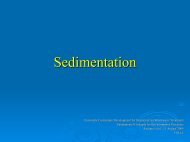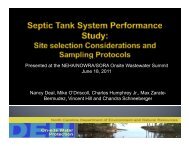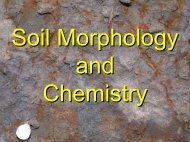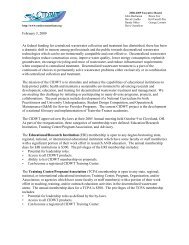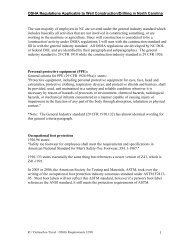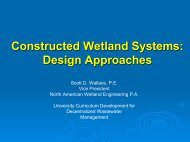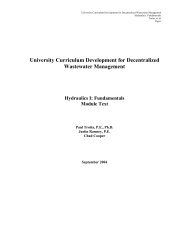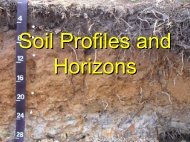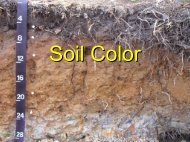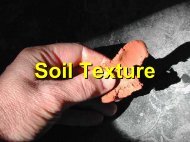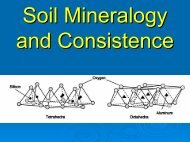Water Movement in Soil
Wastewater Movement in Soils - Consortium of Institutes for ...
Wastewater Movement in Soils - Consortium of Institutes for ...
- No tags were found...
You also want an ePaper? Increase the reach of your titles
YUMPU automatically turns print PDFs into web optimized ePapers that Google loves.
<strong>Water</strong> <strong>Movement</strong> <strong>in</strong><br />
<strong>Soil</strong><br />
James L. Anderson, PhD<br />
David Gustafson<br />
Aziz Amoozegar, PhD<br />
David L<strong>in</strong>dbo, PhD<br />
Model Decentralized Wastewater<br />
Practitioner Curriculum
NDWRCDP Disclaimer<br />
This work was supported by the National Decentralized<br />
<strong>Water</strong> Resources Capacity Development Project<br />
(NDWRCDP) with fund<strong>in</strong>g provided by the U.S.<br />
Environmental Protection Agency through a Cooperative<br />
Agreement (EPA No. CR827881-01<br />
01-0) 0) with Wash<strong>in</strong>gton<br />
University <strong>in</strong> St. Louis. These materials have not been<br />
reviewed by the U.S. Environmental Protection Agency.<br />
These materials have been reviewed by representatives of<br />
the NDWRCDP. The contents<br />
of these materials do not necessarily reflect the views and<br />
policies of the NDWRCDP, Wash<strong>in</strong>gton University, or the<br />
U.S. Environmental Protection Agency, nor does the<br />
mention of trade names or commercial products constitute<br />
their endorsement or recommendation for use.
CIDWT/University Disclaimer<br />
These materials are the collective effort of <strong>in</strong>dividuals from<br />
academic, regulatory, and private sectors of the<br />
onsite/decentralized wastewater <strong>in</strong>dustry. These materials have<br />
been peer-reviewed reviewed and represent the current state of<br />
knowledge/science <strong>in</strong> this field. They were developed through a<br />
series of writ<strong>in</strong>g and review meet<strong>in</strong>gs with the goal of<br />
formulat<strong>in</strong>g a consensus on the materials presented. These<br />
materials do not necessarily reflect the views and policies of<br />
North Carol<strong>in</strong>a State University, and/or the Consortium of<br />
Institutes for Decentralized Wastewater Treatment (CIDWT).<br />
The mention of trade names or commercial products does not<br />
constitute an endorsement or recommendation for use from<br />
these <strong>in</strong>dividuals or entities, nor does it constitute criticism for<br />
similar ones not mentioned.
Citation<br />
Gustafson, D., J. Anderson, A. Amoozegar, and<br />
D.L. L<strong>in</strong>dbo. 2005. <strong>Water</strong> <strong>Movement</strong> <strong>in</strong> <strong>Soil</strong>–<br />
Power Po<strong>in</strong>t Presentation. <strong>in</strong> (D.L. L<strong>in</strong>dbo and<br />
N. E. Deal eds.) Model Decentralized<br />
Wastewater Practitioner Curriculum. National<br />
Decentralized <strong>Water</strong> Resources Capacity<br />
Development Project. North Carol<strong>in</strong>a State<br />
University, Raleigh, NC.
<strong>Water</strong> movement<br />
‣ Why is this important?<br />
‣ How Systems work<br />
‣ Flow patterns<br />
Unsaturated<br />
• Biomat<br />
• Unsaturated<br />
Saturated<br />
• Darcy’s Law<br />
• Saturated<br />
‣ Flow direction<br />
• Lateral movement<br />
• Vertical movement<br />
‣ <strong>Soil</strong> impacts
Why is it important?<br />
‣ Keys to where it goes<br />
‣ Keys to how it moves<br />
• Unsaturated<br />
• Saturated<br />
‣ Identifies potential problems
Hydrologic Cycle<br />
Precipitation<br />
ET<br />
Saturated flow<br />
Restrictive layer<br />
Unsaturated flow<br />
Well<br />
Regional water table
Hydrology Components<br />
‣ Precipitation<br />
‣ Evapotranspiration<br />
‣ Infiltration<br />
• Surface flow (run-off)<br />
• Subsurface flow<br />
• lateral flow, <strong>in</strong>terflow, shallow groundwater flow<br />
• Vertical seepage<br />
Vertical seepage<br />
• deep percolation, groundwater recharge<br />
‣ Unsaturated Zones"<br />
• Capillary fr<strong>in</strong>ge<br />
‣ <strong>Water</strong> table<br />
• Saturated
RAINFALL<br />
(48-54 Inches/Year)<br />
POTENTIAL ET<br />
(36-40 Inches/Year)<br />
CROPLAND<br />
FORESTLAND<br />
INFILTRATION<br />
SURFACE<br />
RUNOFF<br />
SURFACE<br />
WATER<br />
WATER TABLE<br />
GROUND WATER FLOW<br />
AQUIFER RECHARGE<br />
(1/2 TO 2 Inch/Year)<br />
CONFINED LAYER AQUTARD<br />
CONFINED AQUIFER
Recharge area<br />
Discharge<br />
area<br />
<strong>Water</strong> table<br />
GROUND WATER<br />
SYSTEM<br />
Decades<br />
Centuries<br />
Years<br />
Days<br />
Flow l<strong>in</strong>es<br />
Millennia<br />
Direction and rate of ground-water movement.
Precipitation<br />
Septic System<br />
Well<br />
Infiltration<br />
Evapotranspiration<br />
Wastewater<br />
Input<br />
Runoff<br />
Ground <strong>Water</strong><br />
Mound<strong>in</strong>g<br />
Deep<br />
Percolation<br />
Lateral Flow<br />
Slowly Permeable layer<br />
<strong>Water</strong> Table<br />
Stream<br />
Vadose Zone<br />
Ground <strong>Water</strong><br />
Slow Mov<strong>in</strong>g<br />
Impermeable Layer
Precipitation<br />
Septic System<br />
Well<br />
Infiltration<br />
Evapotranspiration<br />
Wastewater<br />
Input<br />
Ground <strong>Water</strong><br />
Mound<strong>in</strong>g<br />
Lateral Flow<br />
Slowly Permeable layer<br />
Deep<br />
Percolation<br />
Vadose Zone<br />
Runoff<br />
Stream<br />
<strong>Water</strong> Table<br />
Ground <strong>Water</strong><br />
Slow Mov<strong>in</strong>g<br />
Impermeable Layer
<strong>Water</strong> thru the<br />
<strong>Soil</strong> Treatment Area<br />
‣ What is water<br />
‣ What is sewage<br />
‣ Onsite systems<br />
• System geometry<br />
‣ Flow patterns<br />
‣ Idealized system
<strong>Water</strong>- What is it ?<br />
‣ <strong>Water</strong> is a di-polar, “charged” molecule<br />
‣ The charges create bonds<br />
‣ These bonds create adhesive and<br />
cohesive forces among molecules and<br />
surround<strong>in</strong>gs<br />
Hydrogen atom<br />
Oxygen atom<br />
105 o +<br />
-
-<br />
+<br />
H-bond<br />
+ -<br />
+<br />
-<br />
BONDS<br />
AND WATER DIPOLES
Sewage<br />
‣ What is it?<br />
• <strong>Water</strong><br />
• Bacteria food<br />
• BOD<br />
• Nutrients<br />
TSS<br />
• Solids<br />
• TSS<br />
• Pathogens<br />
• Solutes<br />
• Others<br />
‣ How much is<br />
Produced?<br />
• 120-150 150 gpd<br />
per bedroom*<br />
• 50-75 gpd<br />
per person<br />
‣ Where is it Produced?<br />
• Bathroom [60%]<br />
• Toilet 40%<br />
• Bath<strong>in</strong>g 20%<br />
• Kitchen [20%]<br />
• Laundry [20%]
Flow to the System<br />
‣ Amounts<br />
• Daily<br />
• Design<br />
• Monthly<br />
• Average<br />
• 60-70% of Design<br />
• Annually<br />
• 50-60% of Design<br />
‣ Variation <strong>in</strong> flow<br />
• Daily totals<br />
• Comes <strong>in</strong> SHOTS<br />
‣ Waste strength<br />
• Biomat development
System def<strong>in</strong>ition<br />
Use<br />
Pretreatment<br />
F<strong>in</strong>al treatment & dispersal<br />
<strong>Soil</strong> treatment area [SAT]
System geometry<br />
Infiltrative surface<br />
Infiltrative surface
‣ Influences:<br />
‣ Longer area<br />
• Smaller<br />
load<strong>in</strong>g<br />
‣ Shorter length<br />
System Geometry<br />
• Greater<br />
down slope impact<br />
Long<br />
Short
Dra<strong>in</strong>age<br />
Contour L<strong>in</strong>es<br />
Dra<strong>in</strong>field<br />
Direction of Ground water Flow
Dra<strong>in</strong>age<br />
Contour L<strong>in</strong>es<br />
Dra<strong>in</strong>field<br />
Direction of Ground water Flow
Dra<strong>in</strong>age<br />
Contour L<strong>in</strong>es<br />
DRAINFIELD<br />
Direction of Ground water Flow
Dra<strong>in</strong>age<br />
Dra<strong>in</strong>field<br />
Direction of Ground water Flow
Flow pattern <strong>in</strong> sub-surface<br />
surface<br />
trench<br />
Unsaturated flow<br />
Saturated Conditions<br />
Unsaturated flow<br />
Mounded Groundwater<br />
Saturated flow
Unsaturated vs. Saturated<br />
Unsaturated<br />
‣ Pores: Air available<br />
‣ Slower:<br />
Next to particles<br />
‣ Aerobic<br />
flow<br />
Saturated<br />
‣ Pores: Volume filled<br />
with water<br />
‣ Faster:<br />
In large pores<br />
‣ Non aerobic
Saturated Conditions<br />
Pores are<br />
filled with<br />
water
Unsaturated Conditions<br />
Pores are filled<br />
with air & water<br />
along the soil<br />
particles
HYDROLOGY OF A SEPTIC SYSTEM<br />
Infiltration from<br />
Trenches<br />
Vertical <strong>Movement</strong><br />
through the<br />
Unsaturated Zone<br />
Lateral <strong>Movement</strong><br />
<strong>in</strong> the Saturated Zone<br />
Least Permeable<br />
Ground <strong>Water</strong> Mound<strong>in</strong>g and<br />
Formation of a Saturated Zone<br />
Slowly Permeable Layer
Flow pattern <strong>in</strong> sub-surface<br />
surface<br />
trench<br />
Least Permeable<br />
Ground <strong>Water</strong> Mound<strong>in</strong>g and<br />
Formation of a Saturated Zone<br />
Slowly Permeable Layer
<strong>Soil</strong> terms<br />
‣ <strong>Soil</strong> Horizon<br />
‣ <strong>Soil</strong> Profile<br />
‣ Texture<br />
‣ Structure<br />
‣ Consistence<br />
• M<strong>in</strong>eralogy<br />
‣ Pore size<br />
‣ <strong>Soil</strong> color<br />
Topsoil<br />
Subsoil<br />
Parent Material
10/2/2003 <strong>Soil</strong> and Site. L<strong>in</strong>dbo et al. DRAFT 5
What is unsaturated flow<br />
• Matric potential<br />
• Tension<br />
• Suckicity factor<br />
• Capillary attraction<br />
• Adhesion<br />
• Cohesion<br />
• How does this happen<br />
• Vertical movement<br />
• Lateral movement
‣ Tension<br />
• Suction<br />
• High-to<br />
to-low<br />
Potential<br />
‣ Impacts<br />
Matric potential
Pore size & unsaturated flow<br />
‣ Large pores<br />
water will<br />
moved<br />
predom<strong>in</strong>antly<br />
by gravity<br />
‣ Small pores<br />
water will move<br />
<strong>in</strong> all directions<br />
better & further<br />
Large Pores<br />
Small Pores
Capillary Attraction<br />
‣ Adhesion – attraction between dissimilar<br />
materials<br />
‣ Cohesion –attraction between similar<br />
materials
Capillary Fr<strong>in</strong>ge<br />
‣ Unsaturated zone above the water table<br />
‣ <strong>Water</strong> held <strong>in</strong> this zone by tension (matric<br />
potential, adhesive and cohesive forces)<br />
‣ This zone is generally not important to us,<br />
and is difficult to measure
How does unsaturated flow <strong>in</strong><br />
the soil treatment area happen?<br />
‣ Unsaturated flow is the key<br />
‣ Biomat formation<br />
• BOD<br />
• Oxygen relationship<br />
• TSS<br />
‣ Pressure distribution
Flow pattern <strong>in</strong> a gravity<br />
trench<br />
‣ Biomat Growth (t = 0 = start )
Flow pattern <strong>in</strong> a gravity<br />
trench<br />
‣ Biomat Growth (t = growth)
Flow pattern <strong>in</strong> a gravity<br />
trench<br />
‣ Biomat Growth (t=mature)
Flow pattern with<br />
Pressure Distribution
Pressure distribution
Biomat & sidewalls<br />
‣ Biomat develops along the bottom and then around the<br />
trench<br />
‣ Pond<strong>in</strong>g levels use sidewalls<br />
‣ Excessive pond<strong>in</strong>g depths may create saturated flow<br />
‣ Narrower allows more surface area<br />
‣ Narrower allows better O2 transfer
<strong>Soil</strong> treatment area siz<strong>in</strong>g<br />
‣ Sewage effluent characteristics<br />
‣ <strong>Soil</strong> properties<br />
• Texture<br />
• Structure<br />
• Consistence/ M<strong>in</strong>eralogy<br />
‣ The biomat<br />
‣ Hydraulic conductivity?
Long Term Acceptance Rate<br />
LTAR<br />
‣ The biomat controls the ability of the soil to<br />
accept effluent: this is the LTAR<br />
‣ Generally State codes dictate LTARs<br />
‣ CONFUSION<br />
• On the relationship of LTAR & Ksat<br />
• Hold on we will get there<br />
• on the relationships between texture/structure<br />
Constance and the Perc rate
LTAR<br />
‣ Texture/ Structure<br />
‣ Other tests-<br />
Saturated conductivity<br />
Percolation rates<br />
<strong>Soil</strong> Characteristics and <strong>Soil</strong> Siz<strong>in</strong>g Factor<br />
(> 3' separation)<br />
Percolation Rate <strong>Soil</strong> Siz<strong>in</strong>g Factor<br />
m<strong>in</strong>utes per <strong>in</strong>ch <strong>Soil</strong> Texture square feet/ gallon<br />
(mpi) per day(sqft/ gpd)<br />
faster than 0.1* Coarse sand 0.83<br />
0.1 to 5 Medium sand 0.83<br />
Loamy sand<br />
0.1 to 5** F<strong>in</strong>e sand 1.67<br />
6 to 15 Sand y loam 1.27<br />
16 to 30 Loam 1.67<br />
31 to 45 Silt loam 2.00<br />
Silt<br />
46 to 60 Clay loam 2.20<br />
Sandy clay<br />
Silty clay<br />
over 61 to 120*** Clay<br />
Sandy clay<br />
4.20<br />
Silty clay<br />
slower than 120****<br />
*Use systems for rapidly permeable soils:<br />
pressure distribution or serial distribution with<br />
no trench >25% of the total system.<br />
**<strong>Soil</strong> hav<strong>in</strong>g 50% or more f<strong>in</strong>e sand plus very f<strong>in</strong>e sand.<br />
***A m ou n d m u st be u sed .<br />
****An oth er or p erform an ce system m u st be u sed
Influenc<strong>in</strong>g the Biomat<br />
Good<br />
‣ Design<br />
‣ Load<strong>in</strong>g<br />
• Hydraulic<br />
• Organic<br />
‣ Rest<strong>in</strong>g<br />
‣ Depth of cover<br />
• Oxygen availability<br />
Bad<br />
‣ Peroxide<br />
‣ Acid
Saturated soils conta<strong>in</strong> free<br />
Free water is not under a suction, and<br />
water<br />
flows <strong>in</strong> response to gravity.
What is Saturation<br />
‣ A horizon is saturated when the soil water<br />
pressure is zero or positive<br />
‣ This water has a pressure greater than<br />
atmospheric pressure, and pushes air out<br />
of holes <strong>in</strong> the ground<br />
In layman's terms<br />
‣ <strong>Water</strong> flows from the soil <strong>in</strong>to a hole
Auger hole <strong>in</strong> soil is filled<br />
with air just after digg<strong>in</strong>g<br />
<strong>Water</strong> table<br />
Air
Auger hole <strong>in</strong> soil is filled<br />
with air just after digg<strong>in</strong>g<br />
<strong>Water</strong> table<br />
Air<br />
14 psi
<strong>Water</strong> below water table has pressure greater<br />
that air pressure<br />
<strong>Water</strong> table<br />
Air<br />
<strong>Water</strong> pushes air out of hole
Eventually hole fills with water to the level of<br />
the water table where<br />
water pressure=air pressure<br />
Unsaturated soil<br />
(water pressure<br />
< air pressure)<br />
Air<br />
Saturated soil<br />
(water pressure<br />
>air pressure)
F<strong>in</strong>d<strong>in</strong>g saturation <strong>in</strong><br />
soils<br />
Identify<strong>in</strong>g saturation by look<strong>in</strong>g for free<br />
water is easy to do <strong>in</strong> the field with<br />
pits or auger holes.
Saturated flow<br />
Onsite System<br />
• Gravity<br />
• Slope<br />
• Hydraulic gradient<br />
• Restrictions<br />
• <strong>Soil</strong><br />
Percolation<br />
Evaporation<br />
Well<br />
Groundwater<br />
Gradient
Darcy’s law<br />
Flow (Q)/At = Ksat x dH/dL<br />
‣ Saturated Flow<br />
‣ Ksat<br />
‣ Slope<br />
‣ Applications
Some approximate values of<br />
Saturated Hydraulic Conductivity & comments<br />
Ksat Ksat Comments<br />
(cm/s)<br />
(<strong>in</strong>/h)<br />
1 x 10 -2<br />
5 x 10 -3<br />
5 x 10 -4<br />
5 x 10 -5<br />
Calculat<strong>in</strong>g Ksat<br />
‣ In lab process<br />
‣ Double r<strong>in</strong>g <strong>in</strong>filtrometer<br />
‣ Amoozemeter read<strong>in</strong>g<br />
‣ Perc tests?<br />
Double r<strong>in</strong>g <strong>in</strong>filtrometer
Elevation 102<br />
40’ apart<br />
Elevation 98<br />
Sand Ksat = 10 <strong>in</strong>/hr<br />
Q (1 sqft) = Slope x Ksat x Area<br />
= (102’- 98’)/ 40’ x 10 <strong>in</strong>/hr x 1 sqft<br />
= 4’/40’ x 10 <strong>in</strong>/hr x 1sqft x ft/12”<br />
= .083 cuft/hr x 7.5 gal/cuft x 24 hr/day<br />
= 15 gpd per sqft
Calculation of Q<br />
‣ A = 1 ft 2<br />
‣ Ksat = 10 <strong>in</strong>/hr<br />
‣ Convert Ksat to ft/hr<br />
‣ 10 <strong>in</strong>/hr X 1ft/12<strong>in</strong><br />
‣ = 0.83 ft/hr<br />
‣ Gradient = dH/dL<br />
dL<br />
‣ = (102’-98’)/40’ = 4’/40’<br />
‣ = 0.1
Calculation of Q<br />
‣ Q = K x dH/dL<br />
dL x A<br />
‣ = 0.83 ft/hr x 0.1 x 1 ft 2<br />
‣ Q = 0.083 ft 3 /hr<br />
‣ Calculate GPD<br />
‣ 7.5 gal/ft 3 x 0.083 ft 3 /hr x 24 hr/d<br />
‣ 7.5 gal/ft<br />
3 x 0.083 ft 3 /hr<br />
x 24 hr/d<br />
‣ Q = 15 gal/day
Lateral movement<br />
L<strong>in</strong>ear Load<strong>in</strong>g Rate<br />
‣ Overall system issue<br />
‣ Controlled by “smallest w<strong>in</strong>dow”<br />
‣ Related to:<br />
• Over all length<br />
• Over all [Compound<strong>in</strong>g] flow
Slope Considerations<br />
1<br />
2 Horizontal Flow 3
Bouma Study<br />
‣ Biomat = LTAR<br />
‣ BUT Be Careful<br />
‣ Relationship to biomat {crust<strong>in</strong>g} rates<br />
‣ Limits are different for sand:clay
Where the two flows meet<br />
‣ Trenches<br />
• Biomat: : Flow control<br />
‣ Unsaturated zone<br />
• Separation<br />
• Treatment<br />
‣ Mound<strong>in</strong>g<br />
• Rais<strong>in</strong>g of saturated levels<br />
‣ Ground water<br />
• Saturated flow
Putt<strong>in</strong>g it together<br />
Backfilled<br />
<strong>Soil</strong><br />
<strong>Soil</strong> Surface<br />
Gravel<br />
Air Space<br />
Distribution<br />
Pipe<br />
Wastewater<br />
Saturated<br />
Zone<br />
<strong>Water</strong> Flow<br />
Path<br />
Unsaturated Zone<br />
NOT TO SCALE<br />
<strong>Water</strong> Table or an Impermeable layer
Groundwater Mound<strong>in</strong>g<br />
‣ What is it<br />
• The rais<strong>in</strong>g of the saturated zone above a<br />
restriction or watertable<br />
‣ Calculation?<br />
• Simple (Darcy’s law)<br />
• Complex (e.g., Modflow)<br />
‣ Tough to apply<br />
‣ The closer you are to the water the more<br />
important mound<strong>in</strong>g becomes
Summary of Influences on<br />
System performance<br />
‣ Saturated conditions<br />
• Lack of treatment<br />
• Preferential flow<br />
‣ Too high a LLR<br />
• Down slope surfac<strong>in</strong>g [blow out]<br />
‣ Excessive biomat growth<br />
• Organic load<strong>in</strong>g<br />
‣ Construction soil damage
Conclusions<br />
‣ Flow above/through the Biomat is<br />
saturated<br />
‣ Flow <strong>in</strong>to the soil from the biomat is<br />
unsaturated<br />
‣ Biomat reduces/controls the flow from a<br />
system<br />
‣ Flow is generally vertical<br />
‣ More research is necessary
Hydrologic cycle<br />
Precipitation<br />
Septic System<br />
Well<br />
Infiltration<br />
Evapotranspiration<br />
Wastewater<br />
Input<br />
Ground <strong>Water</strong><br />
Mound<strong>in</strong>g<br />
Deep<br />
Percolation<br />
Lateral Flow<br />
Runoff<br />
Slowly Permeable layer<br />
Vadose Zone<br />
Stream<br />
<strong>Water</strong> Table<br />
Slow Mov<strong>in</strong>g<br />
Ground <strong>Water</strong><br />
Impermeable Layer
Homework<br />
‣ Questions<br />
‣ Trench example<br />
• Calculate downward movement<br />
• Lateral movement<br />
• Biomat impacts<br />
‣ Darcy’s Law




